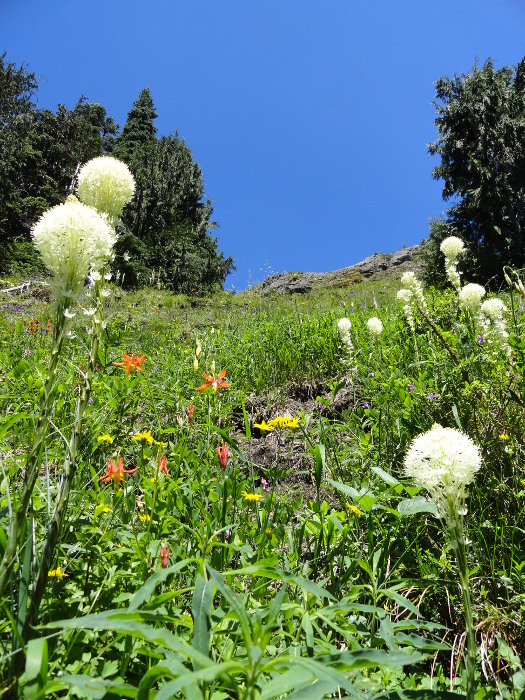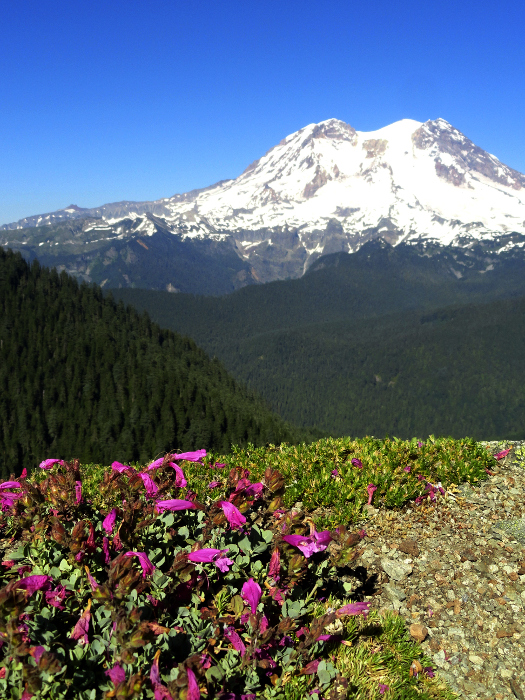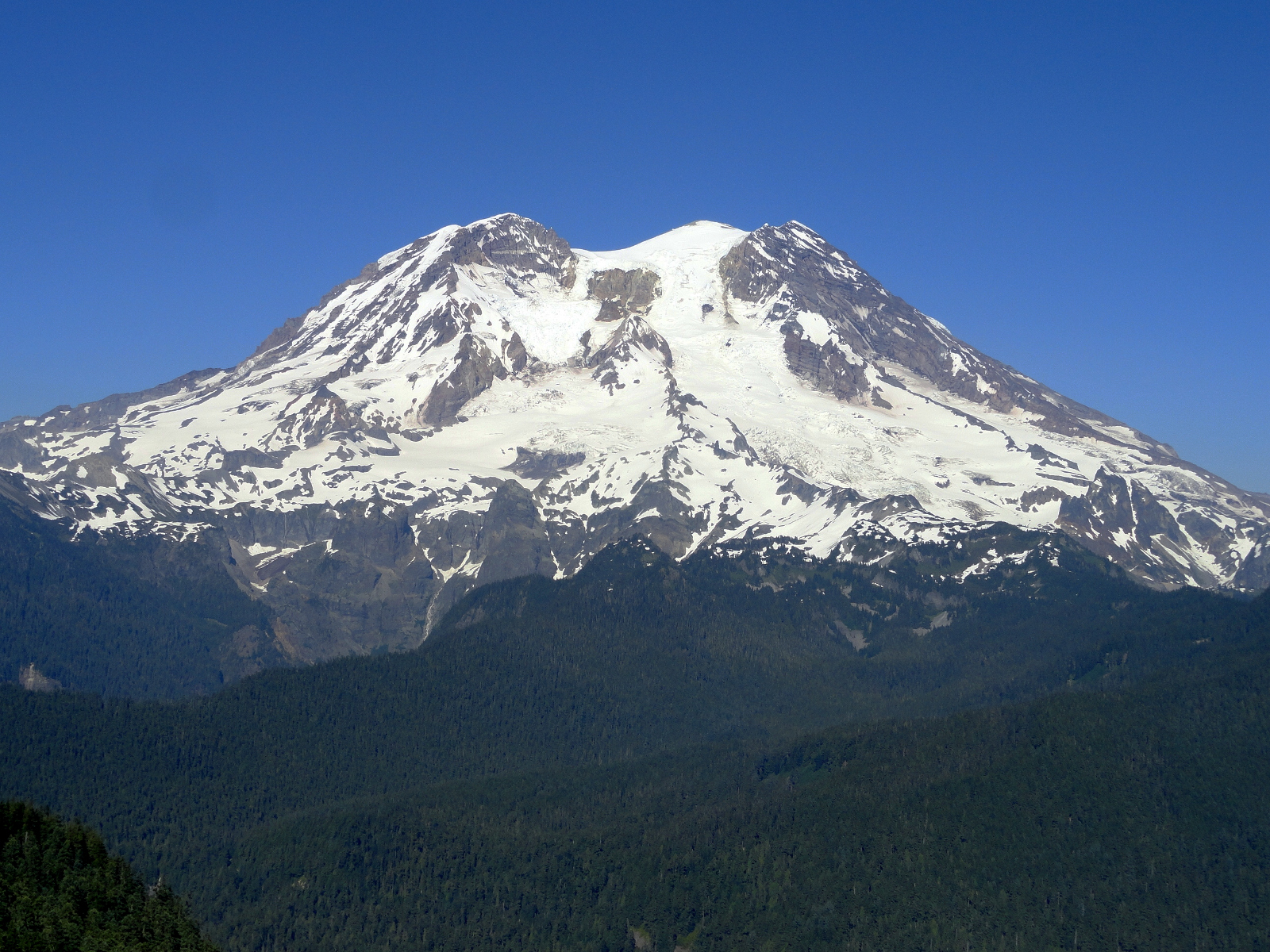Appropriately named, Glacier View affords exceptional glacial views. This small jagged knob on the periphery of Mount Rainier National Park once hosted a fire lookout. When you stand on the summit of this peak however, your focus will be more on ice than on fire. Located just a few miles from Washington’s iconic volcano, Glacier View offers close-up views of the massive ice fields adorning Rainier’s western face.
Glacier View is located within the tiny and not well-known 3,080-acre Glacier View Wilderness Area. To the east, it’s a wilderness of ancient trees, alpine meadows, and peaks of rock and ice. And to the west, industrial tree farms and state forestlands reveal a rolling patchwork of clear-cuts and regenerating forest. It’s quite a contrast. Glacier View’s position on a lofty wedge between two great glacial troughs also allows you to stare down into the deep U-shaped Puyallup River and Nisqually River valleys. The hike is short and not too difficult and the views are grand; but a rough access road and more popular trails in nearby Mount Rainier National Park appear to keep hiker traffic here light.
From the trailhead located high on a ridge at the edge of an old clear-cut, sign in at the kiosk and start hiking. Immediately pass a small wetland, enter the Wilderness, and come to a junction. The trail to the right descends to the lovely Beljica Meadows and provides access to trails leading to Mount Beljica, Goat Lake and Gobblers Knob (dogs prohibited) within Mount Rainier National Park. They are all worthy destinations warranting return trips to this trailhead. But for now, head left to Glacier View.
The way travels north steadily climbing along a sawtooth ridge making up the western boundary of the wilderness area. Once threatened by logging, this small wedge of high elevation forest, meadows and lakes bordering Mount Rainier National became a wilderness area in 1984. This not only created a wild buffer between the park and the heavily logged forests to the west, but also permanently protected several small wildlife-rich bodies of water and guaranteed several miles of trails would remain intact and non-motorized.
The trail skirts a pointy knoll, one of several along the ridge crest. It then descends before steadily climbing again. At a small gap the trail bends left to dart under the rocky summit of a 5,507-foot (1,679 m) unnamed summit, the highest peak in the wilderness area. Traverse more steep slopes before reaching a junction at 1.8 miles (2.9 km) on the ridge crest.
The trail to the right steeply drops off of the ridge making its way to Lake West and Lake Helen. The old Glacier View Fire Lookout site is to your left. After a short and steep climb, break out of the forest and reach the rocky 5,450-foot (1661 m) summit at 2.1 miles (3.4 km). Your eyes will instantly be drawn to Mount Rainier crowding the eastern horizon. The mountain’s icy breath practically blows down upon you. The view is amazing and mesmerizing and you’ll have a hard time concentrating on anything but the long ribbons of glacial ice streaking down from Rainier’s frosty summit. Try to locate the Tokaloo Spire beneath the massive Puyallup Glacier.
Once you can break Rainier’s spell, cast your eyes elsewhere admiring the emerald forests of the Glacier View high country. Look south to Mount Beljica rising above lush meadows and old clear cuts. Look north and west over miles of industrial forests to the population centers of the Puget Sound lowlands. On clear days you can see out to the Olympic Mountains across the Sound. It’s obvious why a fire lookout once graced this rocky outpost.
While the 1930s-built lookout was removed in 1960 and nothing now remains of it, from this point you can see two lookouts that still stand. Look west to the Puyallup Ridge Lookout best reached in winter by snowshoeing or skiing the maintained trails of the Mount Tahoma Trails Association system. Look east to Gobblers Knob located within the national park on a small promontory north of Mount Wow’s big, blocky summit. This restored lookout can be reached by trail either from hiking past Goat Lake within the Glacier View Wilderness—or from the east in the park via a trail from the West Side Road.
While the sweeping views will keep you satisfied, try to cast your glances downward too to admire the beargrass and array of wildflowers adorning the summit. Glacier View invites you to spend some time basking in glorious scenery. Not a bad payoff for a relatively short and easy hike. And it’s pretty amazing too that you just might have all of this beauty and wilderness to yourself.
Craig Romano is an award-winning author of more than twenty hiking guidebooks, including 100 Classic Hikes Washington (Mountaineers Books) which spotlights the very best hikes capturing the full essence of the Evergreen State.

Location: Glacier View Wilderness, Nisqually River Valley, WA
Distance: 4.2 miles (6.8 kilometers) roundtrip
Elevation gain: 1,000 feet (305 meters)
Difficulty: moderate
Trail notes: kid-friendly, dog-friendly, wilderness rules apply; free day permit required—sign in at trailhead. Practice Leave No Trace principles. FR 59 is rough in spots but is passable for passenger cars
Trail highlights: exceptional views of Mount Rainier, old fire lookout site
Contact: Cowlitz Valley Ranger Station (Randle), Gifford Pinchot National Forest
Getting to the trail: From Tacoma follow SR 7 to Elbe. Then continue on SR 706 east (passing through Ashford) for 11 miles (17.7 km). Turn left onto graveled FR 59 (Copper Creek Road) and follow for 8.6 miles (13.8 km) to road’s end and trailhead.

Did you find this article useful and informative? Please consider becoming a supporting reader. Cascadia Magazine depends on the generous financial donations of readers like you to pay our writers and photographers a fair rate for their work. If you’re already a supporting reader, thank you!

